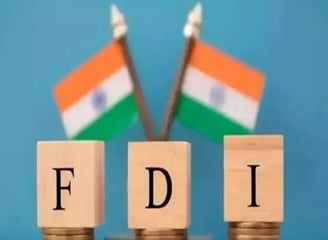Add your promotional text...
India's Foreign Direct Investment Soars: A Sign of Renewed Economic Confidence in 2024
Synopsis: The Indian economy has seen a robust 26.4% surge in Foreign Direct Investment (FDI) during the first quarter of 2024, reflecting growing global investor confidence. Key sectors like manufacturing and financial services are driving this growth, while traditional exports shift towards electronics and engineering goods. With India’s foreign exchange reserves hitting a historic high and a moderated current account deficit, the country is poised for sustained economic resilience and expansion.
MARKETSINDIA
By Sameer Malhotra
8/20/20243 min read


The Indian economy has witnessed a remarkable surge in Foreign Direct Investment (FDI) during the first quarter of the current financial year. According to the latest data released by the Reserve Bank of India (RBI) in its monthly bulletin, gross FDI inflows have soared by an impressive 26.4% to reach $22.5 billion in the April-June 2024 period. This represents a significant uptick compared to the same quarter in the previous financial year.
Net FDI Shows Positive Momentum
This influx of gross FDI has translated into a substantial increase in net FDI as well. The net FDI for the first quarter of 2024-25 stands at $6.9 billion, up from $4.7 billion during the same period in 2023-24. This growth trajectory underscores the increasing confidence of global investors in India’s economic prospects.
Key Sectors Driving FDI Inflows
Several sectors have emerged as major contributors to the FDI inflows, with manufacturing, financial services, communication services, computer services, and energy sectors taking the lead. Together, these sectors account for approximately 80% of the total gross FDI inflows, highlighting their pivotal role in driving India’s economic growth.
Leading Source Countries
The RBI report also identifies the key source countries for FDI into India. Singapore, Mauritius, the Netherlands, the United States, and Belgium have emerged as the top investors, collectively contributing 75% of the total FDI inflows. This diverse investor base underscores India’s attractiveness as a global investment destination.
Historical Context of FDI Flows
It’s worth noting that the net FDI flow into India had experienced a significant decline in the previous financial year. In 2023-24, net FDI dropped sharply to $9.8 billion from $28 billion in 2022-23. To provide further context, net FDI flows were $38.6 billion in FY22. The recent uptick in FDI inflows signals a potential recovery and renewed investor confidence in the Indian economy.
Revival of India’s External Sector
The RBI’s report paints a positive picture of India’s external sector, highlighting signs of revival in net exports as a driver of growth. After a contraction in 2023-24, outbound shipments from India are expanding in the current financial year. Notably, nine of the top ten export destinations, excluding China, are witnessing increased demand for Indian goods, accounting for about half of the total export value.
Shift in Export Basket
India’s export basket is undergoing a notable transformation. Traditional exports such as gems and jewellery, textiles, garments, leather, and marine products are losing ground, while electronics and engineering goods are gaining prominence. This shift reflects India’s evolving competitive advantages in the global market.
Global Capability Centres and Export Growth
Global capability centres are playing a crucial role in driving India’s export growth. These centres are setting the stage for the evolution of business and knowledge process outsourcing. Business services that support operations such as consulting, engineering, research, and design are rapidly becoming a powerhouse of India’s exports, even surpassing software and information technology services.
Foreign Exchange Reserves and External Sector Resilience
RBI Governor Shaktikanta Das recently highlighted the strength of India’s external sector. As of August 2, 2024, India’s foreign exchange reserves reached a historic high of $675 billion. Governor Das emphasized that key external indicators continue to improve, reinforcing the resilience of the Indian economy.
“We remain confident of comfortably meeting our external financing requirements,” said Das, underlining the robust health of India’s external sector.
Current Account Deficit and Trade Balance
India’s current account deficit (CAD) moderated significantly to 0.7% of GDP in 2023-24, down from 2.0% of GDP in 2022-23. This improvement was driven by a lower trade deficit and strong services and remittances receipts. However, in the first quarter of 2024-25, the merchandise trade deficit widened as imports grew faster than exports. Despite this, the buoyancy in services exports and robust remittance inflows are expected to keep the CAD within a sustainable range in the coming quarters.
In Conclusion, The surge in FDI inflows, coupled with a revival in net exports and a shift in the export basket, underscores the resilience and growth potential of the Indian economy. As global investors continue to show confidence in India’s economic trajectory, the country is poised to maintain its status as a leading investment destination and a key player in the global economy.
